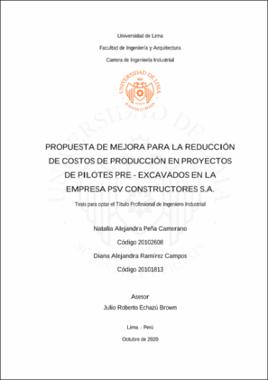Propuesta de mejora para la reducción de costos de producción en proyectos de pilotes pre - excavados en la empresa PSV Constructores S.A.

Ver/
Peña_Camerano_Natalia_AlejandraT.pdf
(application/pdf: 1.474Mb)
(application/pdf: 1.474Mb)
Fecha
2020Asesor(es)
Metadatos
Mostrar el registro completo del ítemResumen
Globalization and human being tendency to create a connection between nature and the infrastructure necessary for industrial activity constitute the most effective combination when generating improvements in the foundations of the great buildings and bridges of the world. The taller a building is or the greater the distance between the supports of a bridge, the greater the demands are of the foundations that support them. Deep foundations carried out with drilled piles have become the most practical and economical solution when satisfying resistance requirements dependent on superstructures.
These piles vary in length and diameter according to the demands of the project, and in order for it to be executed, drilling accessories and heavy machinery are used, that allow in synthesis, to make a hole in the ground, similar to the action of drilling a hole in the wall of a house with an electric hand drill. Drilling tools use consumables known as bits, which constitute the fusible element in the production train, since they have a relatively low cost compared to the cost of the machine itself, and are manufactured and used exclusively to wear out, fracture or fail during the drilling process of the piles.
A priori, there is currently no way to predict the number of bits that will be used in the execution of the piles of an “x” project. The above would have no interest if the bits are made in the country of “x” project, however, because they are brought in from China or Germany by sea, with a delivery time ranging from 45 to 60 days, there is a lot of interest on behalf of the companies. When the estimate of the number of bits is not correct and the project runs out of these consumables without having finished all the drilled piles, the logistics supply chain has to intervene to accelerate the acquisition by air, which also translates to a dead time of production from 7 to 10 days, accompanied by the increase in general expenses, acquisition of a product at a higher cost and the most shocking for the company, penalties for stoppages or being out of contractual term.
Under this context, the question that arises is the following: Is it possible to reduce production costs in a drilling rigs project with certain geometric characteristics that guarantees the profitability of the project and customer satisfaction to avoid negative impacts? La globalización y la tendencia del ser humano a hacer un match entre la naturaleza y la infraestructura necesaria para la actividad industrial, integran la combinación más efectiva a la hora de generar mejoras en los cimientos de las grandes edificaciones y puentes del mundo. Entre más altura tenga un edificio o entre más distancia tengan los apoyos de un puente, mayores serán las exigencias de las cimentaciones que los soportan. Las cimentaciones profundas realizadas con pilotes perforados se han convertido en la solución más práctica y económica al momento de satisfacer los requerimientos de las resistencias dependientes de las superestructuras.
Estos pilotes varían en longitud y diámetro según las demandas del proyecto, y para su proceso de ejecución se utilizan accesorios de perforación y maquinaria pesada que permite, en síntesis, realizar un agujero en el suelo, similar a la acción de perforar una pared de una casa con un taladro eléctrico de mano. Las herramientas de perforación utilizan unos consumibles conocidos como “picas”, las cuales constituyen el elemento fusible en el tren de producción, dado que presentan un costo relativamente bajo comparado con el costo de la máquina en sí, y se fabrican y se usan exclusivamente para que se desgasten, fracturen o fallen durante el proceso de perforación de los pilotes.
De manera a priori, no existe actualmente una manera de predecir el número de picas que se utilizarán en la ejecución de los pilotes de un proyecto. Lo anterior no tuviera ningún interés si no fuera porque estos insertos no se fabrican en el país, sino que se traen desde China o Alemania vía marítima con un tiempo de entrega que oscila entre los 45 a 60 días. Cuando la estimación del número de picas no es la correcta y el proyecto se queda sin estos consumibles sin haber terminado la totalidad de los pilotes perforados, la cadena de suministro tiene que intervenir para acelerar la adquisición vía aérea, que igual se traduce a un tiempo muerto de producción de 7 a 10 días, acompañado del incremento de los gastos generales, adquisición de un producto a un costo mayor y lo más impactante para la empresa, penalidades por paralizaciones o estar fuera de plazo contractual.
Bajo este contexto, la pregunta problema que nace es la siguiente: ¿Es posible reducir los costos de producción en un proyecto de pilotes pre-excavados con ciertas características geométricas que permitan garantizar la rentabilidad del proyecto y satisfacción del cliente para evitar impactos negativos?.
Cómo citar
Peña Camerano, N. A. y Ramírez Campos, D.A. (2020). Propuesta de mejora para la reducción de costos de producción en proyectos de pilotes pre - excavados en la empresa PSV Constructores S.A. [Tesis para optar el Título Profesional de Ingeniero Industrial, Universidad de Lima]. Repositorio ULima. https://hdl.handle.net/20.500.12724/12032Editor
Universidad de LimaTemas
Tipo de obra
TesisColeccion(es)
- Tesis [1167]
El ítem tiene asociados los siguientes ficheros de licencia:

